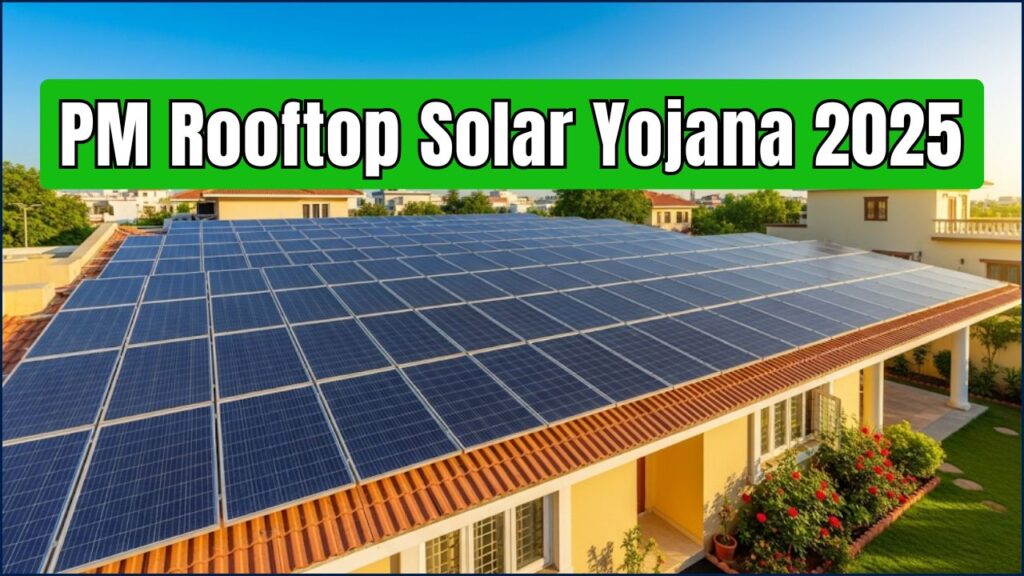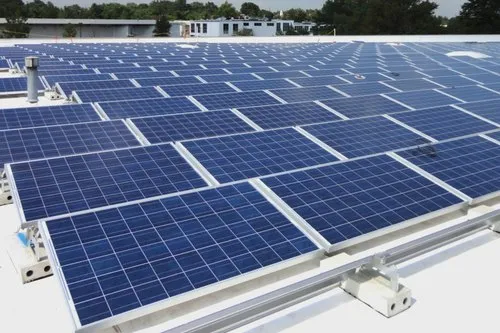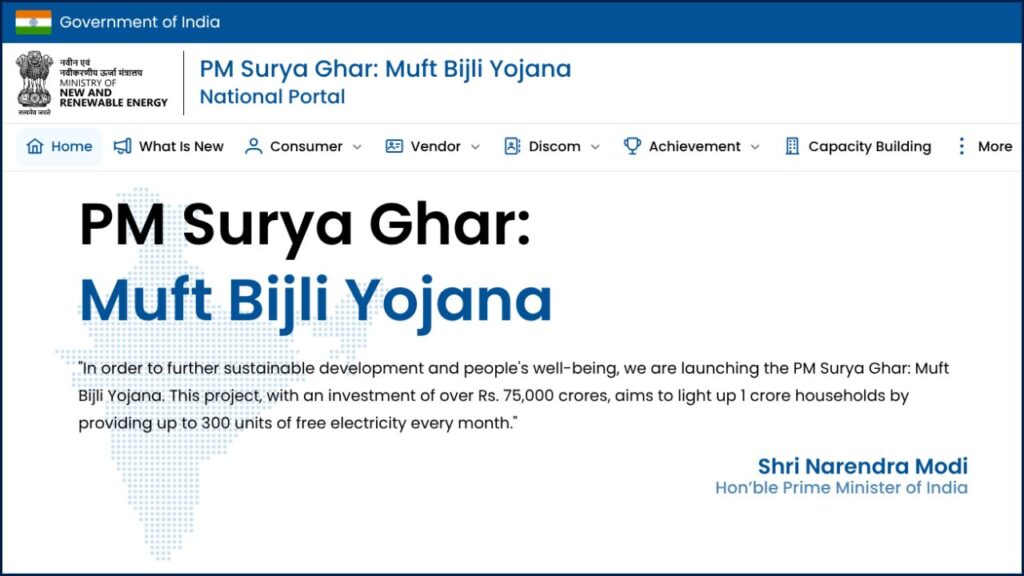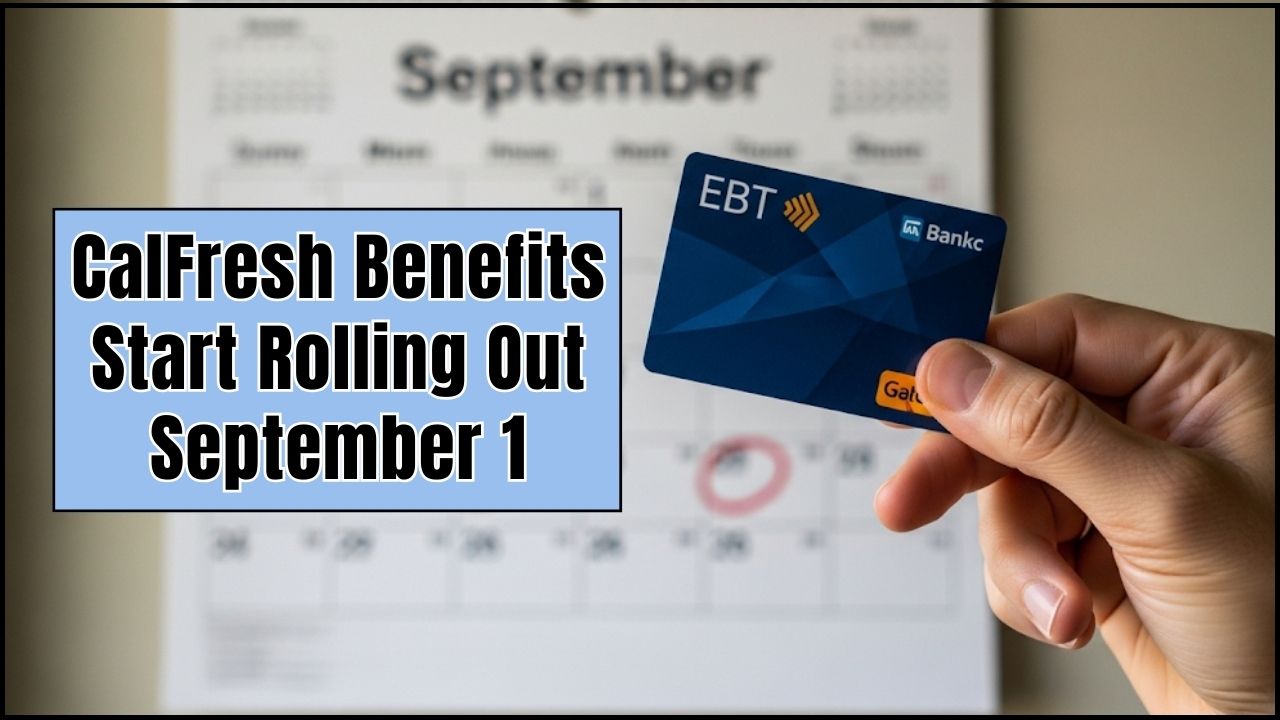PM Rooftop Solar Yojana 2025 is not just another government scheme. It’s a powerful, planet-loving, pocket-saving move designed to help everyday folks in India get up to 300 units of electricity free every month for the next 25 years. Yep, you heard that right—free electricity, solar power style. Whether you’re a farmer in Punjab or a family in Bengaluru, this deal is the real deal.

Launched under the banner of PM Surya Ghar: Muft Bijli Yojana, the initiative is part of India’s aggressive renewable energy push. And it’s about more than just solar panels; it’s about empowering 1 crore (10 million) Indian homes, slashing bills, creating jobs, and future-proofing our energy needs. So, let’s break it down in plain speak.
PM Rooftop Solar Yojana 2025
| Feature | Details |
|---|---|
| Launch Year | 2024 (Rollout for 2025) |
| Goal | 1 crore rooftop solar-powered homes |
| Free Electricity | Up to 300 units/month for 25 years |
| Subsidy | Up to ₹78,000 per home |
| Loan Options | Up to ₹2 lakh @ ~7% interest via national banks |
| System Sizes | 1 kW to 3+ kW based on home usage |
| Eligibility | Indian residents with pucca homes and electricity connections |
| Additional Benefits | Net metering income, home value appreciation, climate contribution |
| Official Website | pmsuryaghar.gov.in |
PM Rooftop Solar Yojana 2025 is more than a policy; it’s a promise of cleaner energy, financial relief, and community growth. It’s not just about saving bucks—it’s about building a future where energy is a right, not a privilege.
So, if you have a rooftop, it’s time to let it pay you back.
What Is PM Surya Ghar: Muft Bijli Yojana?
This government-backed initiative is all about making solar affordable and mainstream. Under this Yojana, households receive a big-time subsidy for installing rooftop solar systems and can generate enough electricity to cover most or all of their needs. Any extra? You can sell it back to the grid (net metering for the win!).

This isn’t just about free electricity—it’s about smart investment and climate action. It puts power (literally) back in the hands of the people, especially middle and lower-income families.
Why You Should Care (Even If You’re a Skeptic)
If the promise of free electricity for 25 years doesn’t light you up, maybe these perks will:
- Massive monthly savings (up to ₹3,000 per month depending on usage)
- No more power cuts (if you add batteries)
- Increase your home value
- Reduce your carbon footprint
- Get cash from surplus power via net metering
- Support India’s renewable energy goals
- Eligible for carbon credits in future policy extensions
And if you’re a business owner or school administrator? It’s a no-brainer. Solar can literally cut overhead costs in half.
Step-by-Step Guide to Apply for PM Rooftop Solar Yojana 2025

1. Check Your Eligibility
You must:
- Own a pucca (permanent) home
- Have a legal electricity connection
- Not have previously availed solar subsidies
- Have an unshaded rooftop space
2. Register Online
- Go to pmsuryaghar.gov.in
- Enter your electricity connection number and select your DISCOM
- Complete KYC with Aadhaar, bank details, and a canceled cheque
3. Select a Vendor
- Choose from empanelled solar vendors listed on the site
- Vendors will inspect your roof, suggest system size, and quote the cost
4. Install the System
- The vendor will install panels, inverters, and net meters
- DISCOM verifies the setup and issues a commissioning certificate
5. Get Your Subsidy
- Once certified, your subsidy is credited directly to your bank account
6. Monitor and Maintain
- Most vendors offer 5 years of free maintenance
- Clean the panels monthly and keep an eye on the app for performance tracking
Real-Life Example
Meet Sunita Devi from Haryana. She installed a 2 kW system under the scheme. Her monthly bill went from ₹1,600 to just ₹80. In summer, she even earns ₹500 per month selling extra power to the grid. Talk about sunshine profits!
Stats That Prove It Works
- Over 3.3 lakh homes in Gujarat have installed rooftop solar
- Expected savings per household: ₹1–2 lakh over 25 years
- Estimated to reduce 720 million tonnes of CO2 over its lifetime
- Boost to local green jobs and vendor ecosystem
- Increase in home resale value by 4-5% (Source: NREL, USA equivalent studies)
Techie Corner: What You Actually Get
- Solar PV Panels (1 kW to 10 kW)
- Grid-tied Inverter for electricity conversion
- Net Meter for power tracking and billing
- Smartphone App to monitor generation in real-time
- Optional battery storage (not covered in subsidy but available for extra)
Old vs. New Solar Subsidies (Illustrative)
Thinking about solar? See how the current PM Surya Ghar Yojana compares to previous subsidy structures, offering even better incentives!
| Feature/Capacity | Previous Solar Subsidy (Example) | PM Surya Ghar: Muft Bijli Yojana (2025) |
| 1 kW System | Approx. ₹18,000 | ₹30,000 |
| 2 kW System | Approx. ₹36,000 | ₹60,000 |
| 3 kW System | Approx. ₹54,000 | ₹78,000 (Maximum) |
| Target Homes | Less defined national targets | 1 Crore households |
| Application | Often via state portals/DISCOMs | Centralized National Portal (pmsuryaghar.gov.in) |
| Free Electricity | Indirect savings | Up to 300 units free electricity per month |
Top 3 Tips for a Smooth Solar Installation:
- Choose a Registered Vendor: Always select a solar vendor empaneled with your DISCOM (Electricity Distribution Company) or registered under the PM Surya Ghar Yojana portal. This ensures eligibility for the subsidy and quality installation.
- Understand Your Electricity Bill: Before applying, check your average monthly electricity consumption. This helps determine the ideal solar system capacity for your home to maximize your free electricity benefit.
- Net Metering is Key: Ensure your chosen vendor assists with the net metering application. Net metering allows you to export surplus solar power back to the grid and receive credits, further reducing your bills.
Top Solar-Friendly States
1. Gujarat
Leading with over 3.3 lakh homes, proactive DISCOM support, and efficient vendor systems.
2. Maharashtra
Rapid scaling in urban areas like Pune and Mumbai, high return due to high tariff rates.
3. Rajasthan & Telangana
Great solar exposure, strong vendor participation, rural reach growing.
4. Delhi & Haryana
Urban policies favor rooftop installations with ease-of-use net metering systems.
FAQs
Q1. How long does it take to get the system installed?
Usually 30 to 60 days from registration to commissioning.
Q2. What if I sell my house?
The solar system adds value! The new owner can enjoy the benefits.
Q3. Are there any hidden costs?
Nope. The subsidy covers a major chunk. You only pay the balance post subsidy.
Q4. Is this available in all Indian states?
Yes, but DISCOM participation varies. Check the portal for details.
Q5. What happens on cloudy days?
You’ll still draw grid power, but on average, you’ll be self-sufficient across the year.
Q6. Can I add batteries later?
Yes! While not included in the subsidy, you can integrate batteries later for backup power.









